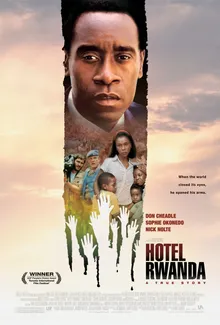Historical accuracy of Hotel Rwanda

Historical accuracy of Hotel Rwanda

Characters
Paul Rusesabagina
Paul Rusesabagina is a real person. While the film is based on his experiences, some aspects of his character and actions have been debated and disputed.
Tatiana Rusesabagina
Tatiana Rusesabagina is Paul's wife, and the film portrays her strength and resilience during the genocide. Her character is based on her real-life experiences, though some dramatic liberties were taken.
Colonel Oliver
Colonel Oliver is a fictionalized representation of the UN peacekeeping forces present in Rwanda during the genocide. He embodies the frustration and powerlessness of the UN forces in the face of the escalating violence.
Georges Rutaganda
Georges Rutaganda was a real figure, a leader of the Interahamwe militia. The film accurately depicts his role in inciting and carrying out the genocide.
Jack Daglish
Jack Daglish is a composite character, representing the foreign journalists who covered the Rwandan genocide.
Story
Paul Rusesabagina's role in saving refugees
Some sources portrays Paul Rusesabagina as a savior sheltering refugees. Others paint a far less flattering picture of his actions during the genocide, claiming that UN troops were instead responsible for keeping people safe in the hotel.
The inaction of the international community
The film effectively highlights the international community's failure to intervene and stop the genocide. The UN peacekeeping force's limited mandate and lack of resources are accurately represented.
The role of the Interahamwe militia
The film portrays the Interahamwe as the primary perpetrators of the genocide, which is historically accurate. Their brutality and role in carrying out the killings are consistent with historical accounts.
The use of the hotel as a safe haven
The Hotel des Mille Collines did become a refuge for many people during the genocide. The film's depiction of the hotel as a relatively safe haven is accurate, although the level of safety fluctuated.
Paul's relationship with his family
The film portrays Paul's deep love for his family and his determination to protect them. While the specifics of family interactions are personal, the overall portrayal of his familial devotion is likely accurate.
The level of violence depicted
While the film depicts significant violence, some argue that it downplays the full extent of the brutality of the genocide. The film's rating likely necessitated some limitations on the graphic depiction of violence.
The motivations of the perpetrators
The film touches upon the complex factors that fueled the genocide, including ethnic tensions, political rivalries, and economic hardship. While the film cannot explore every nuance, it provides a reasonable overview of these factors.
The fate of those who sought refuge in the hotel
The film suggests a relatively positive outcome for those sheltered in the hotel, which is partly true. While many survived, the situation was precarious, and some did not escape.
Setting
The portrayal of the Rwandan genocide
The film provides a powerful and generally accurate depiction of the Rwandan genocide. While some details are condensed or dramatized, the overall picture of the violence and its causes is consistent with historical understanding.
The role of the media in inciting hatred
The film accurately portrays the role of extremist media, particularly radio broadcasts, in fueling the genocide. The film's depiction of the propaganda and hate speech is consistent with historical evidence.
The presence of foreign journalists
The film accurately depicts the presence of foreign journalists in Rwanda during the genocide. Their reporting played a crucial role in bringing international attention to the events.
The speed and scale of the killings
The film effectively conveys the rapid and widespread nature of the killings. The sheer scale of the violence and the speed with which it unfolded are consistent with historical accounts.
The use of machetes as weapons
The film correctly portrays the widespread use of machetes as weapons during the Rwandan genocide. Machetes were readily available and became a symbol of the brutality of the killings.
